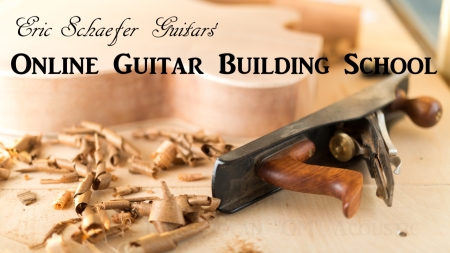Superglue can be a luthier’s best friend or worst enemy. Technically called Cyanoacrylate glue, or CA, in most cases it cures with effectively no wait time. The thinnest viscosities have incredible wicking properties that allow the glue to penetrate a pre-assembled, clamped joint.
However, CA can be a nightmare to work with if you are not ready to deal with the more cantankerous side of CA:
CA is caustic stuff to breathe in. The same properties that allow it to wick into joints also allow it run wild across your workpiece and the quick open time means that sometimes the mess sets before you can clean it up. CA often cures harder than the surrounding wood which makes removing cured CA glue problematic. CA leaves deep, dark stains in spruce that often won’t come out. CA literally makes your eyes burn!!!
In the next 2 episodes, I’m going to answer some common questions about superglue, debunk some myths, and most importantly, discuss some strategies for dealing with the cantankerous side of superglue, so you can benefit from it’s wicking properties and quick cure time without frustration.
Viscosities
CA glue is available in several different viscosities, from waterthin viscosity to a thick gel superglue. I use waterthin CA almost exclusively. The water-thin variety, also called superthin, can be found at hobby stores or from luthier suppliers. Lowes or Home Depot won’t have it. That stuff is too thick. There are cases where medium and thick CA are more suitable, especially any situation where you are worried about runaway glue making a mess. However, I am only talking about water thin CA here because that is what I use 99% of the time. Pretty much any other application that would call for a thicker glue, I don’t use CA for.
Water thin CA spreads by capillary action. This means that the glue literally pulls itself into the tight spaces between joints. As mentioned before, this can be somewhat problematic in certain cases, but you have to give superglue some credit here! No other glue can do what water thin CA glue does! I can dry fit 2 pieces together and then apply the glue while the 2 pieces are held together exactly how I want them. The glue will migrate along the mating surfaces of the 2 pieces (and then possibly continue to migrate further, hence the word “problematic.”). The glue then cures in seconds, or even quicker if accelerator is used.
Safety
I always wear a respirator whenever I use CA glue, and I always use in a well ventilated area. If for some reason, I expect to be using a large amount of CA glue, I wear swimming goggles as well. Yes, swimming goggles. Regular shop goggles are useless against CA glue. The irritating fumes easily get through. Swimming goggles are the only thing that works because they seal around the eyes.
CA soaked paper towels and cloth immediately get thrown in the wood stove, in the unlikely event that they spontaneously combust. You should do the the same thing with rags soaked in a variety of finishes and solvents.
Don’t have a woodstove? Use a metal can, or a bowl of water.
To Accelerate or Not to Accelerate
Commercial “accelerators” are available that can be misted onto CA glue joints to instantly cure the glue. I don’t recommend creating your own homemade accelerator concoctions, because I’d imagine that it would be easy to get the proportions wrong and create something that significantly weakens the bond. Commercial accelerator is inexpensive enough and it works great. Using accelerator can be beneficial in simple tearout repairs, where perhaps you accidentally tore out a chunk of wood. The chunk can be held in place by hand (or with the tip of some object like a paper clip, so you don’t glue your finger to your work) and CA can be wicked down into the joint. In some cases, like on an edge, it can be difficult to hold something in good alignment for a long enough time for the glue to cure on it’s own. In that case, accelerator is a good idea. There are also cases where it makes sense to use accelerator for the sake of your own time and efficiency.
The downside of accelerator is that it weakens the bond a little bit, it can cause “blooming”, and it adds more caustic fumes to the air. So only use accelerator if you have to. Don’t simply accelerate all CA glue joints just because you can. Before you spray, ask yourself if you need the accelerator or if you can afford to wait a minute. “Blooming,” by the way, is the result of spraying too much accelerator too soon. When you do this, the CA bubbles out and turns an offwhite color. This leaves an ugly gob of hard CA to clean up. This can be avoided by waiting about 3 seconds before you spray and spraying above the CA joint, letting the mist fall down onto the CA, rather than spraying it directly.
DIY Dilutions
I recently found out that you can dilute CA with acetone to alter the flow characteristics and essentially create your own viscosity.
I don’t really recommend doing this, because it can be messy, time consuming and it’s not really necessary given the availability of various viscosities from hobby stores. But it is interesting to know that you can. Here is why I did this and how:
This came up during the April class. I ran out of water-thin CA glue during the class and had to experiment a little bit to finish a peghead inlay that the student and I were working on. It was a Sunday and the hobby store was closed, so I could not simply get more water thin CA glue, but I did have a much thicker viscosity superglue handy. This CA, however, was much too thick for the task at hand. The student was leaving for home the next day, and the inlay needed to be finished…
I poured a small amount of the gel CA into one of those travel sized shampoo bottles. The bottle was empty of course without a trace of shampoo or moisture in it. In fact, drying out the bottle with a heat gun after it is cleaned out is critical. Moisture is what cures CA. If there is even a trace of moisture in the bottle, the CA will cure as soon as you pour it in the bottle. Then I added acetone to the bottle until it appeared to flow like water. Important disclaimer: I do not know how much this affects the strength of the bond. I used this trick to finish up some ebony dust fills around an inlay, which is a purely aesthetic use. The rest of the dilution that I made is now reserved for very non-structural fill repairs like this.
With all that said, I don’t really recommend doing this! Just because it is not necessary. It’s a better idea to wait and buy the viscosity that you need. Unless you are building guitars on a strict timeline, like my students and I are during my courses, you shouldn’t need to make your own dilutions ever… but it is interesting to know.
Now some of you may be wondering what I was wondering: How does this work? You may already know that acetone can be also be used to soften cured superglue to aid in it’s removal. It may seem counter-intuitive then that acetone can also be used to dilute CA glue, without making the CA glue incurable. I am not a chemist, but I believe this works because the acetone evaporates off as it’s exposed to air. The way I think of it, the acetone dilutes the CA in the bottle and inhibits the CA from curing in the bottle. This gives the CA the flow characteristics that you want and it doesn’t render the CA inert because as soon the CA wicks down into the joint, it is exposed to air and the acetone evaporates off leaving uninhibited CA glue behind. That’s my guess at why this works, but if anybody has a more science-approved answer, i would love to hear it and share it!
Superglue and Spruce
If you’ve used superglue on guitars long enough, you’ve probably gotten the stuff on unprotected spruce or some other softwood at some point. And you probably have had a glue stain that, no matter how much you sanded and scraped, it just never went away. This is a common problem that can be avoided by either not using superglue on guitar tops, or by applying finish to the area before you use the CA glue. The finish seals the grain so that glue cannot penetrate. Then you simply sand the finish away. This works great for installing rosettes and installing binding and purfling.
In Much Ado about Superglue: part 2 I will cover such as topics as
Glue delivery Strategies
Non-structural Repairs
Dust Fills
Nut Slot Fills
Gluing Frets
Sealing Grain
Cleaning up the mess
Want more of this? Subscribe below for Weekly Guitar Making Tips on “The Small Shop Luthier Blog”
Want to really learn more!? Take a class with Eric Schaefer and build your own guitar in 8 days!

Or Join The Online Guitar Building School



